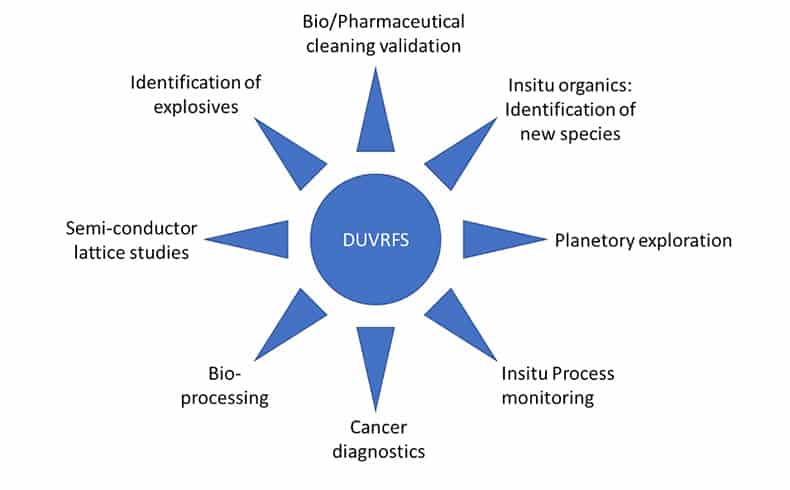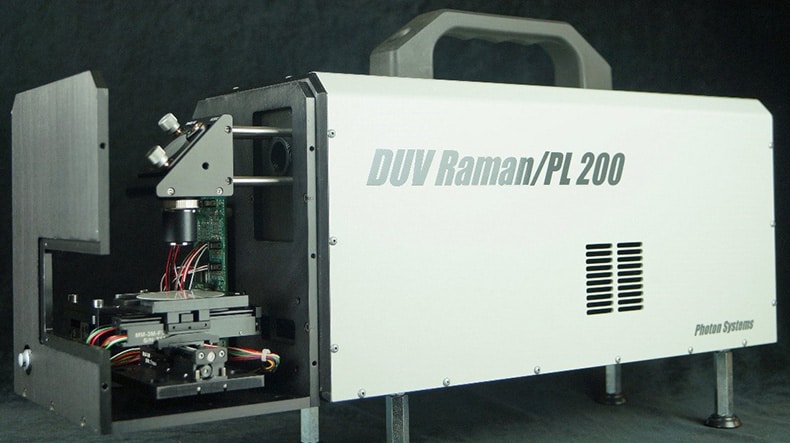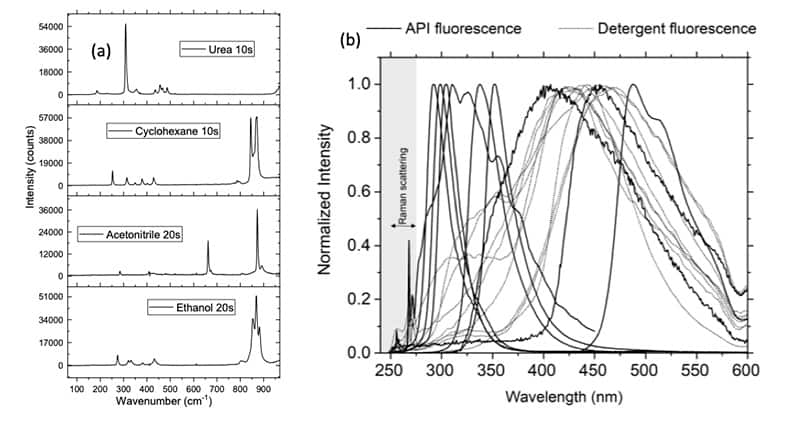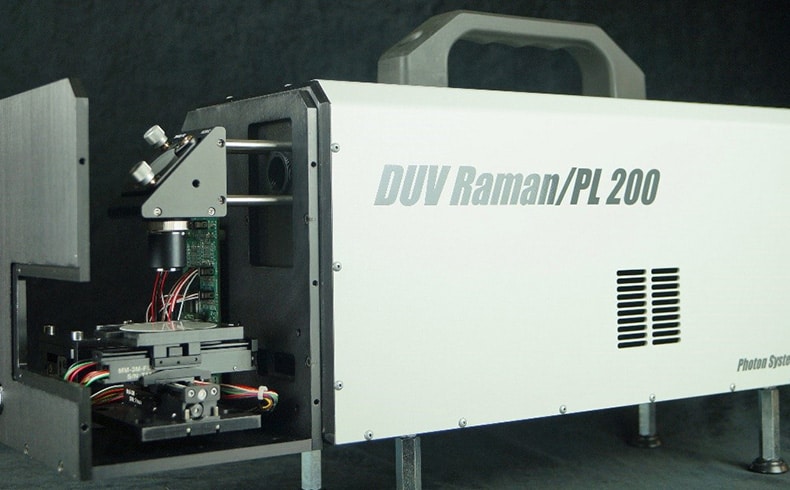Deep Ultraviolet (DUV) excited Raman & photoluminescence spectroscopy is an emerging analytical technology with very high potential for a wide range of commercial, industrial, and research applications. One of the main limitations of conventional Raman spectroscopy using Ultraviolet (UV), visible, or near IR wavelengths is the obscuration of the Raman signals due to background fluorescence originating from the sample or its substrate. This often puts a limitation on the types of materials and compositions or backgrounds for which Raman spectroscopy is functional.
One driving motivation for using DUV Raman as a technique is due to its ability to detect Raman and fluorescence signals simultaneously. This provides complementary information about a targeted material. The Raman scattering usually provides information in a molecular level, like the resonance behaviour, while fluorescence provides information on the overall electronic configuration. Another driving motivation is the ability to detect & map biological material, which is not possible with 1064 nm, 785 nm, or 532 nm Raman methods.

Deep UV Raman Spectroscopy for Bioindustry
Excitation in the Deep Ultraviolet range is known to enhance the inelastic scattering of many biological samples. Specifically, the Raman signal of polypeptide side chains, including aromatic amino acids, are strongly resonantly enhanced. Aromatic amino acids such as tryptophan and tyrosine strongly absorb UV light around 280 nm and 230 nm, allowing for their Raman scattering resonance enhancement. Phenylalanine exhibit strong resonance enhancement of Raman signals when excited at deep UV below 200 nm. Resonance Raman spectra of aromatic amino acid residues provide important information about the tertiary structure of proteins.
Additionally, deep UV excitation resonantly enhances the Raman scattering of the amide chromophore, a building block of the polypeptide backbone. This enhancement provides information regarding the secondary structure of a protein; as such, Deep Ultraviolet Raman Spectroscopy (DUVRS) is extremely useful for investigating proteins within biological samples. Resonance
enhancement of nucleic acids has also been observed via deep UV excitation due to their light absorption in the same range. Both proteins and nucleic acids play influential roles in biochemical processes and are therefore anticipated to be helpful in distinguishing between biological samples, making deep UV excitation uniquely advantageous as compared to excitation using visible or near-IR light.
Novel applications of Deep UV Raman and Fluorescence spectroscopy in the bioindustries include bio-processing, cancer diagnostics, insitu process monitoring, planetary exploration, semi-condcutor lattice studies, identification of new species, pharmaceutical cleaning validation and identification of explosives.
CAPPA Specialist Expertise
CAPPA has been committed to extending their capabilities in deep UV Raman detection for the past two years. Wasatch photonics introduced the first compact, modular UV Raman spectrometer, the WP 248 from Wasatch Photonics with initial inputs from CAPPA. It covers the range 400-3200 cm-1 with 14 cm-1 resolution, and is designed for use with a 248.6 nm NeCu laser. This, in combination with a 250 mW high power laser from Photon instruments, provides a free space deep UV Raman system that can be used for samples in bulk, such as liquids, that can’t be exposed and bulk solids. This contributes to a stand off Raman unit which can measure bulk samples and has a macroscopic resolution of 1-10 cm. Stand off measurements up to 100 cm can be attempted with the same set up. This combination is unique in Ireland.

As well as the the DUV Raman spectrometer and laser, CAPPA also has a PL 200 deep UV Raman spectrometer which enables Raman mapping of 10-200 µm. Integration of an XZY mapping stage and microscopic imager to the DUV Raman PL 200 enables the acquisition of chemical and organics maps on any matrix (area of over 25 cm2). Trace samples upto ng/cm2 can be identified using the PL 200 spectrometer.


The biopharmaceutical industry currently faces major challenges because of increasing competition in the field due to the market entry of biosimilars and increasing costs in research and development of new drugs. One challenge the biopharma industry has is in the monitoring of quality control in continuous manufacturing. The miniature deep UV Raman is able to provide quality control in continuous manufacturing. It is able to provide instrumentation for real-time detection of the key ingredients during continuous flow manufacturing. The miniature deep UV raman instrument avoids fluorescence interference or obscuration and provides a high level of sensitivity and specificity for the ingredients. Another challenge in the biopharma industry is rapid cleaning verification. The current solution is to augment or replace the present swab and test methods for equipment cleaning verification with a faster and better controlled and documented method. The solution to this is with the Deep UV Raman PL 200. This handheld device quantifies trace amounts of API in real time on manufacturing resulting in significantly reducing production down time.
Since the advancement of lasers in Deep UV is only recent, Raman microscopes had limited availability in Deep UV. As a result, the new systems available at CAPPA are unique in Ireland. These Deep UV systems can support SME’s in the bio-pharmaceutical industry to enable cheaper production, faster development, and improved quality of the biologics to gain a competitive edge in a global market. In addition to supporting the biopharmaceutical industry, the benchtop UV raman will support a wider range of R&D in agriculture, food processing, medical devices, pharmaceutical, medical diagnostics and health care.
You can learn about the facilities available at CAPPA here and more about CAPPA’s previous work in the bioindustries sector here.
This post was first published on the CAPPA website.
